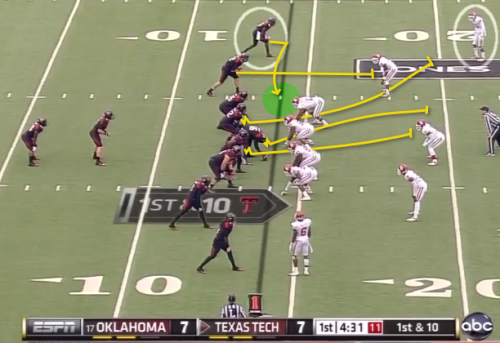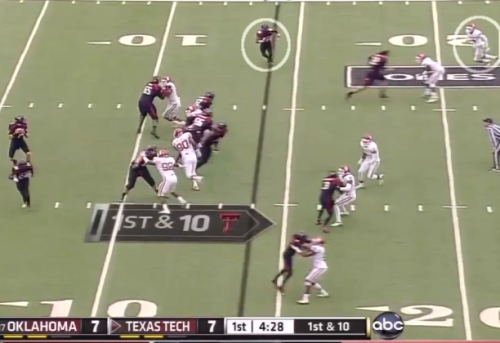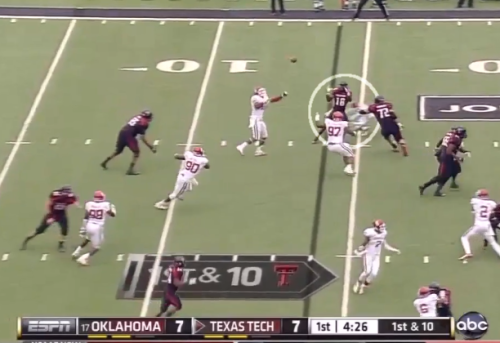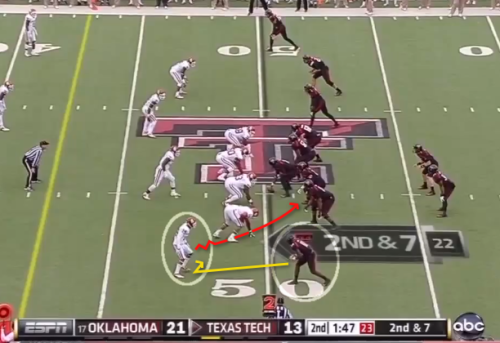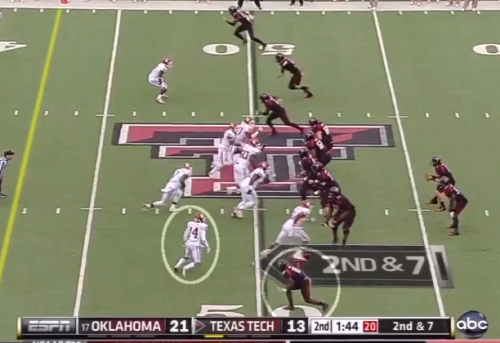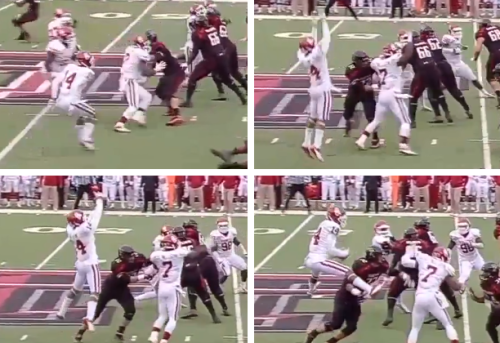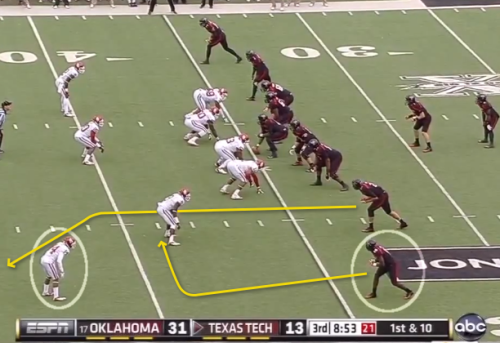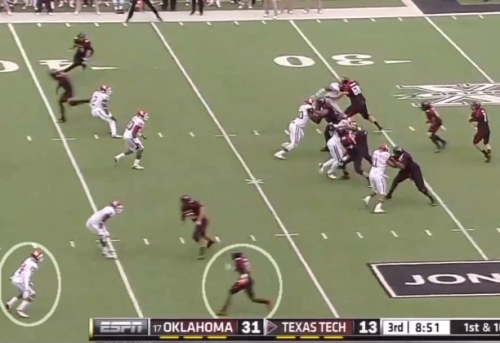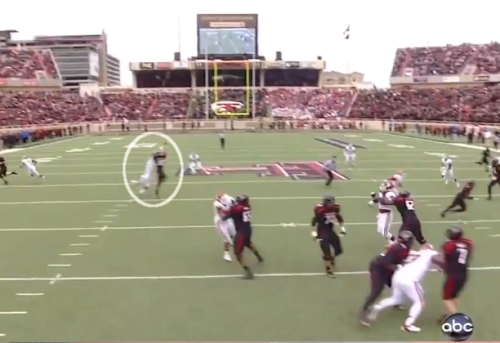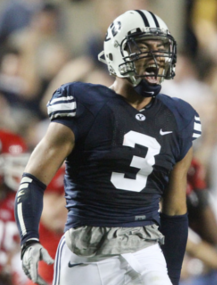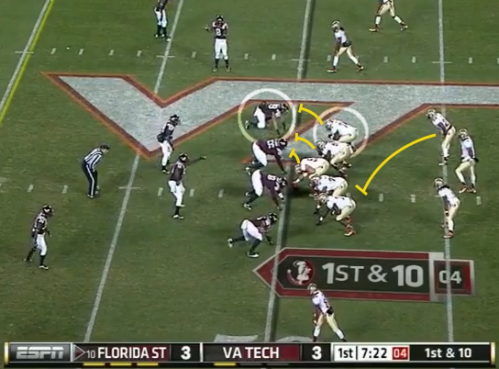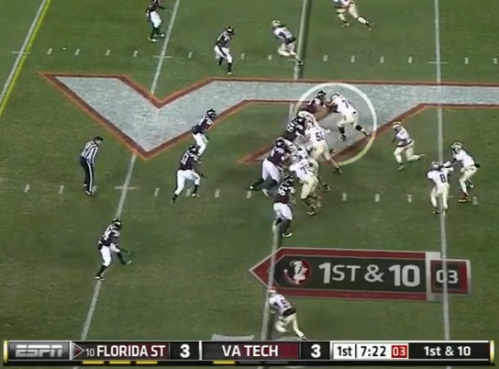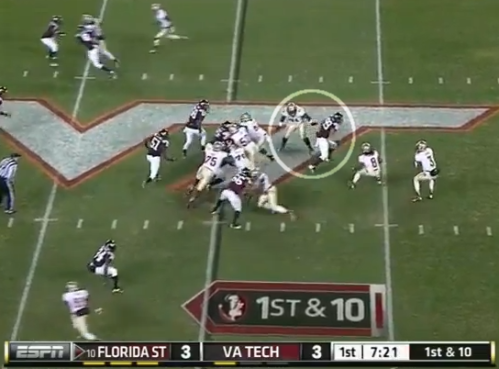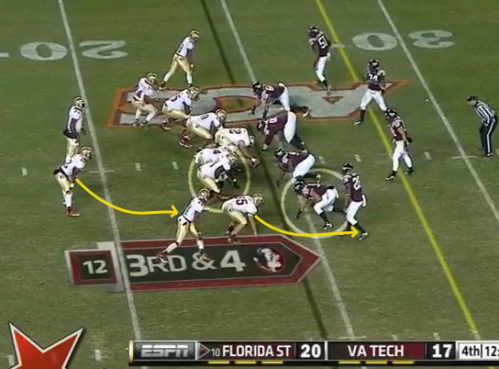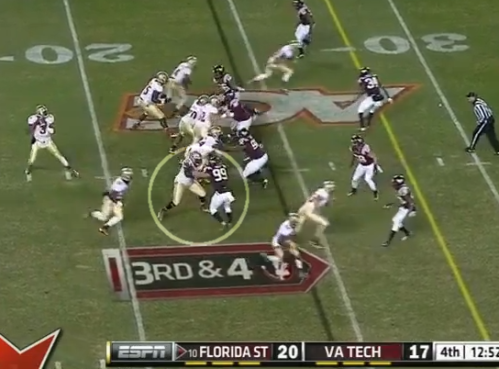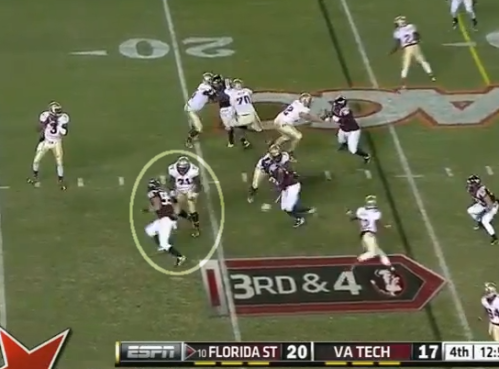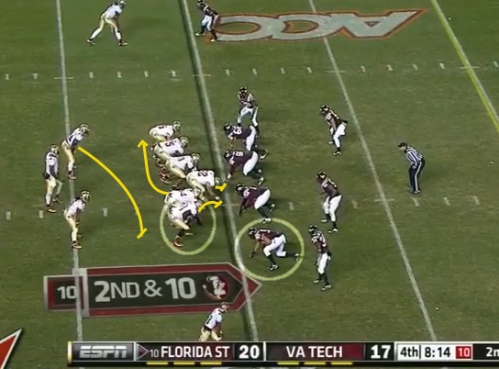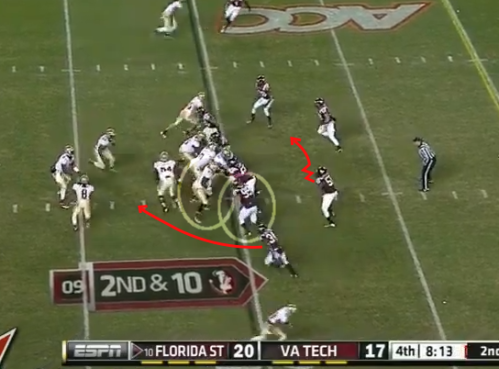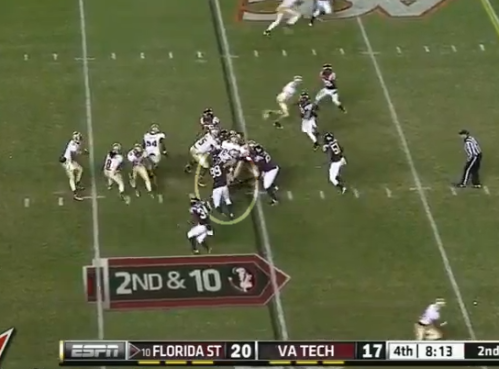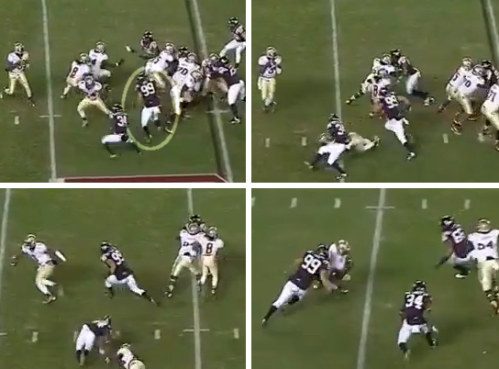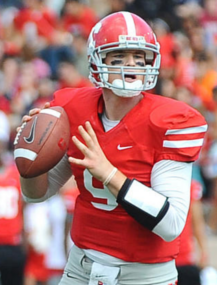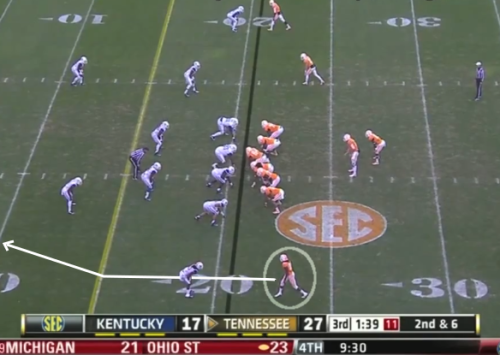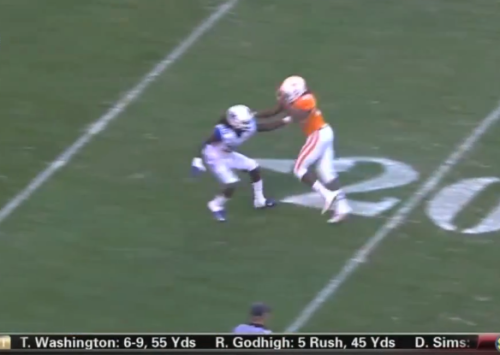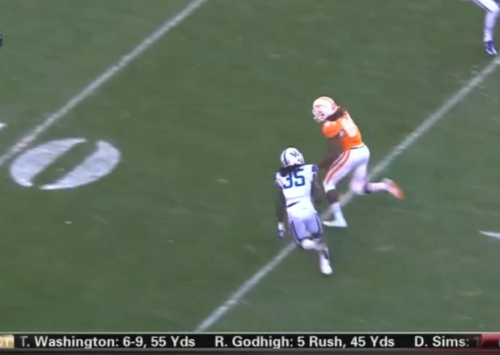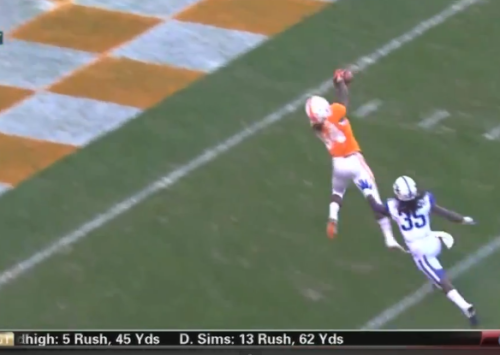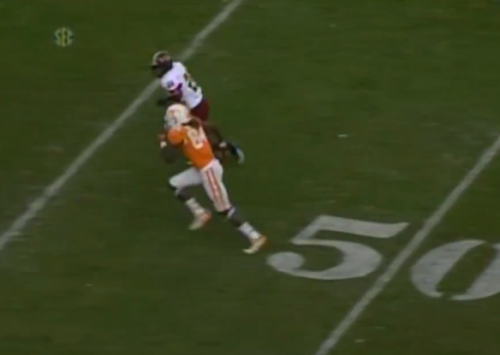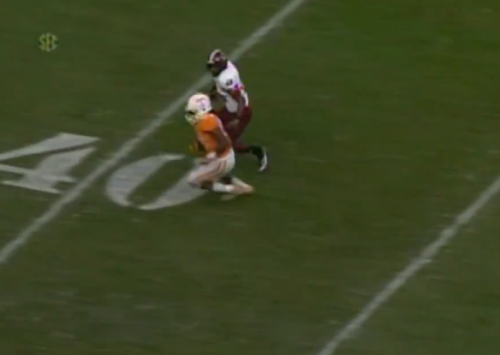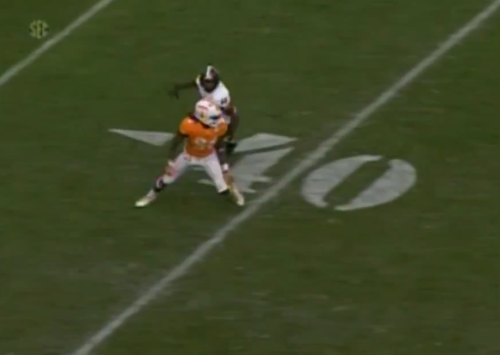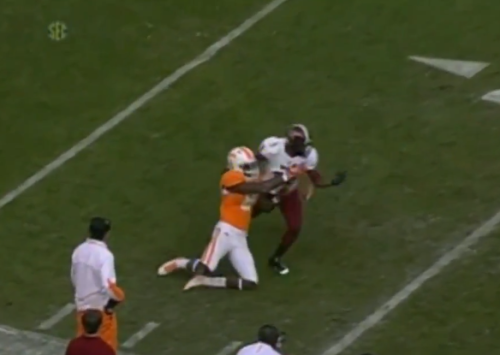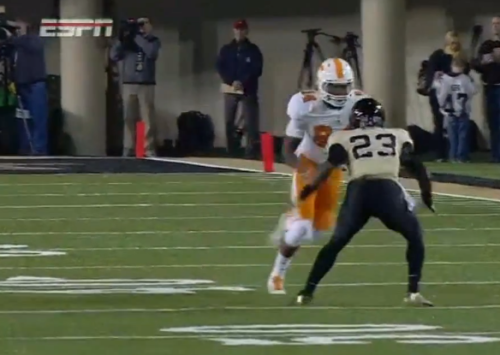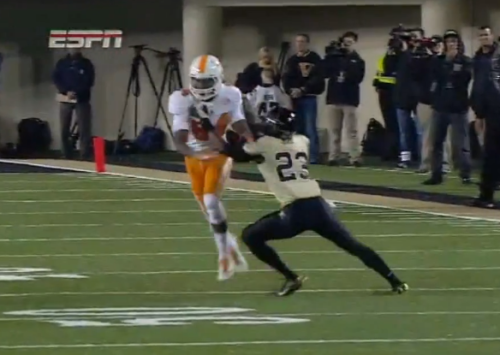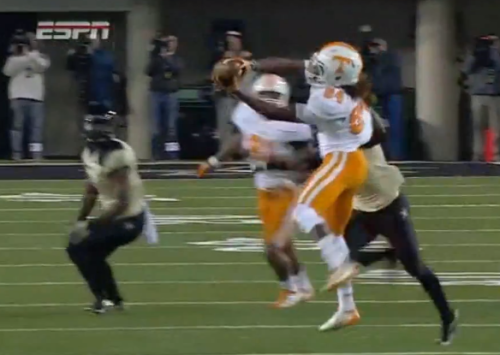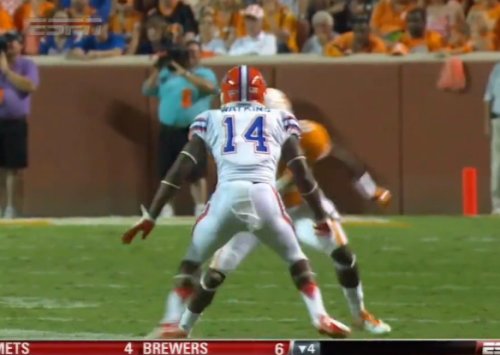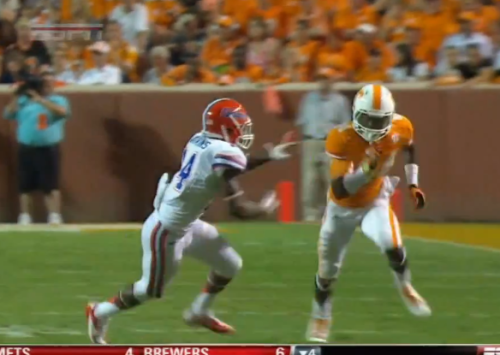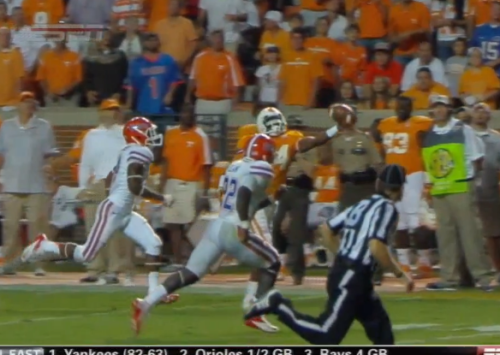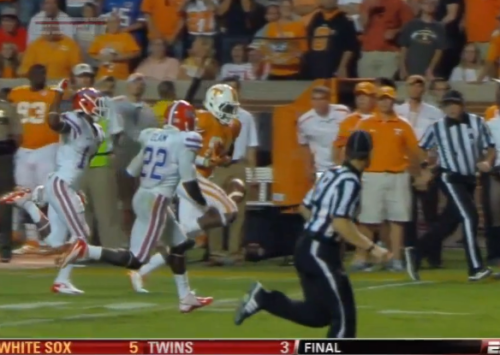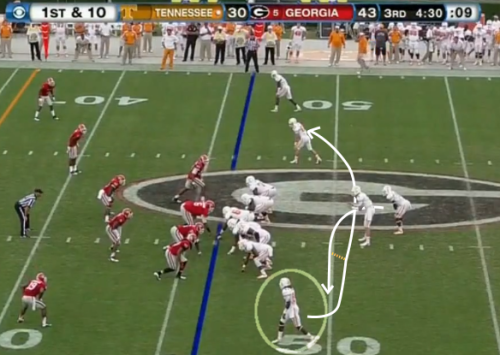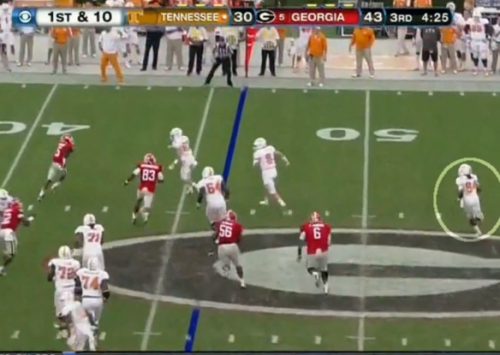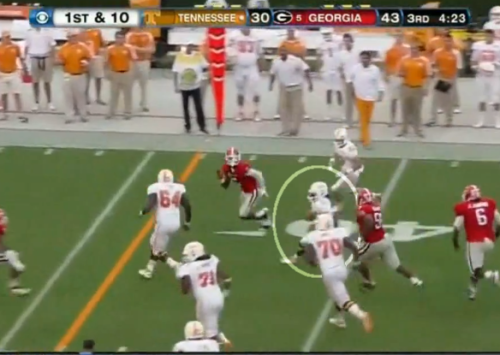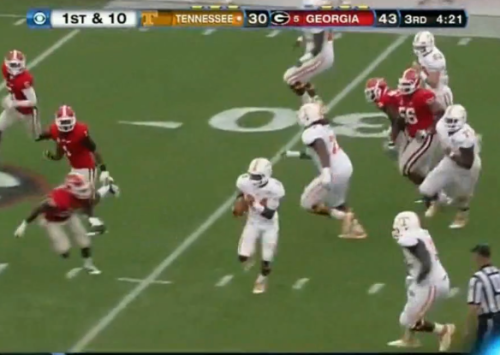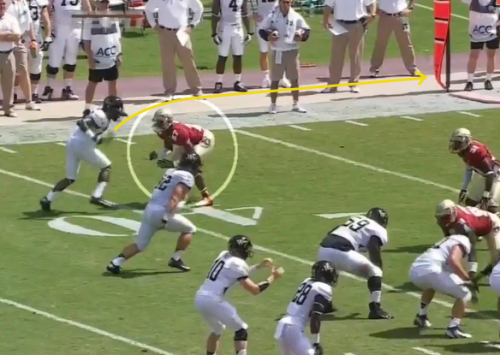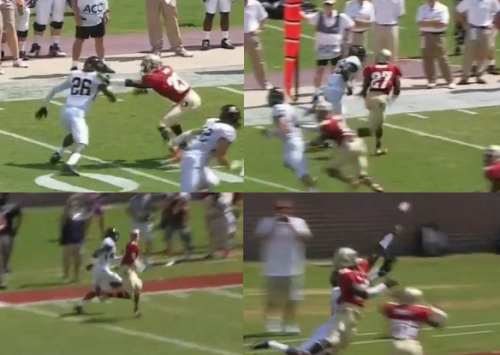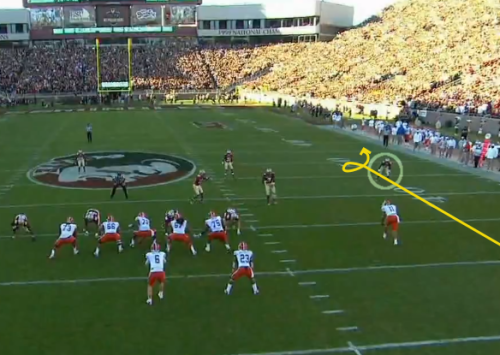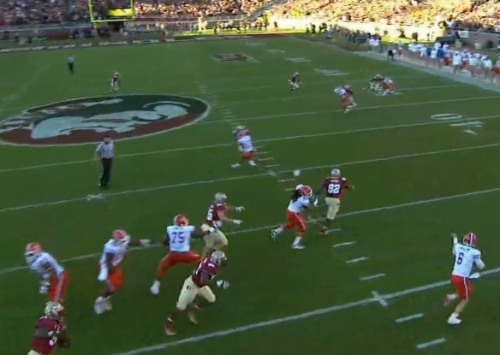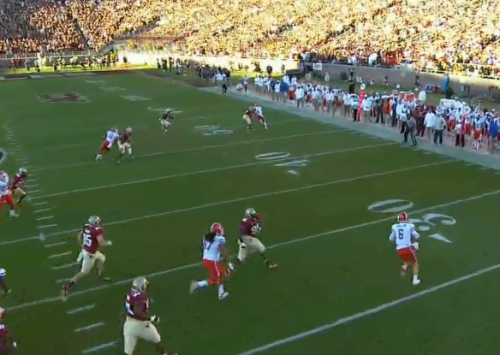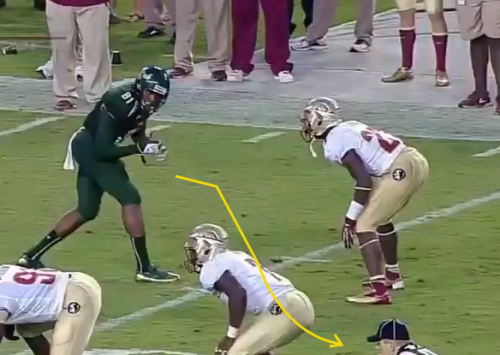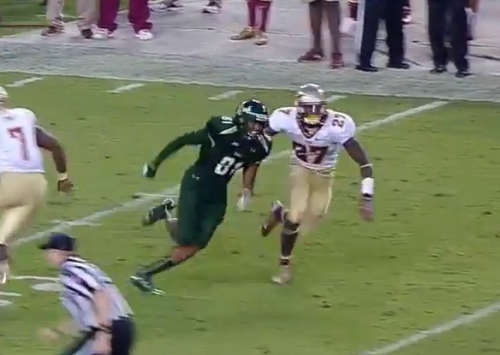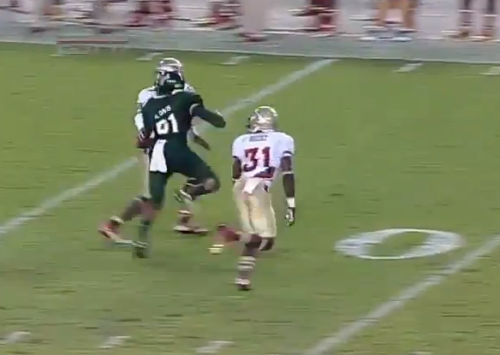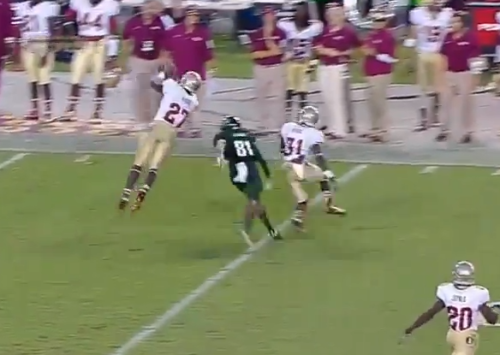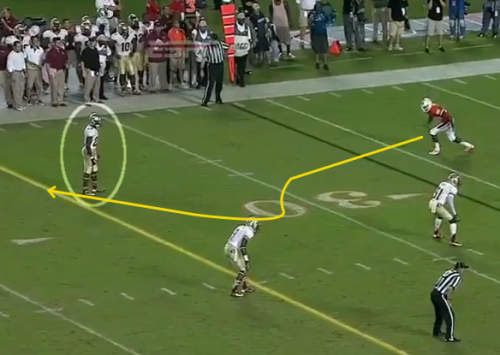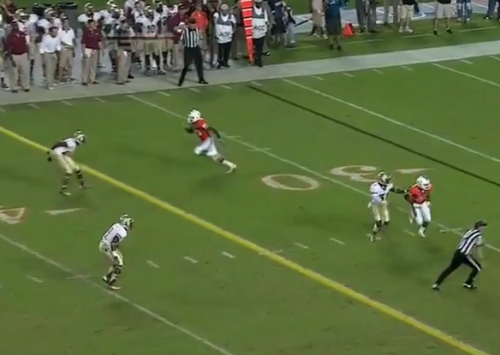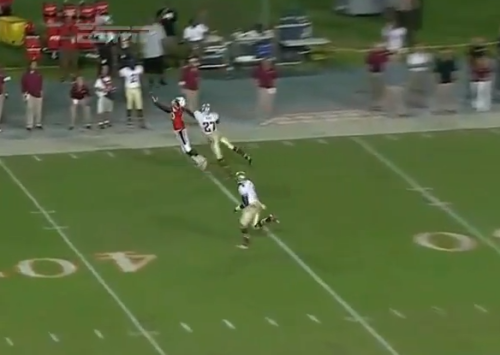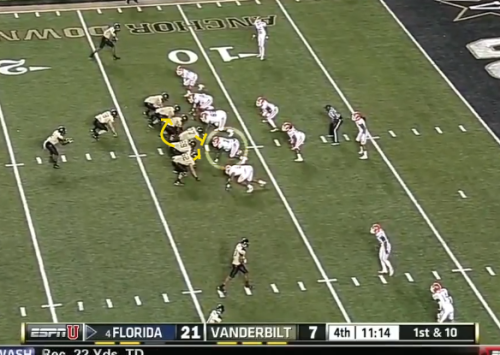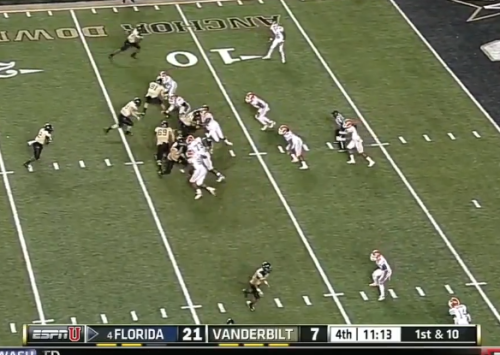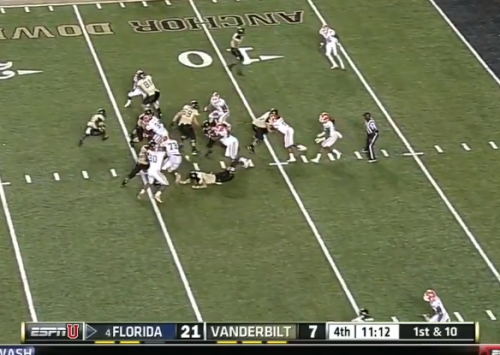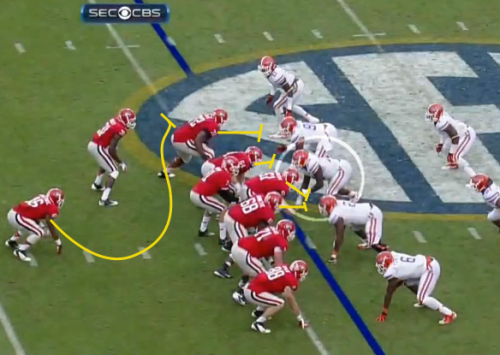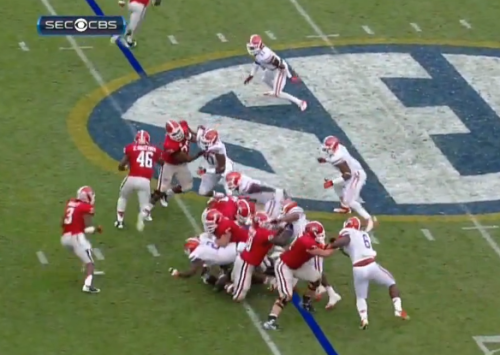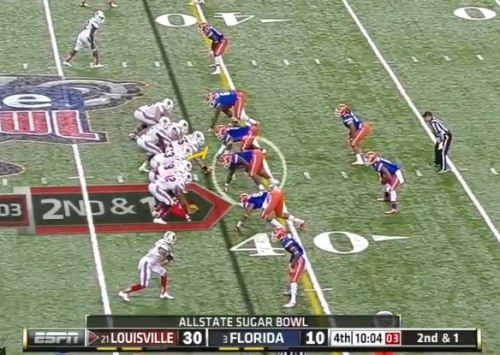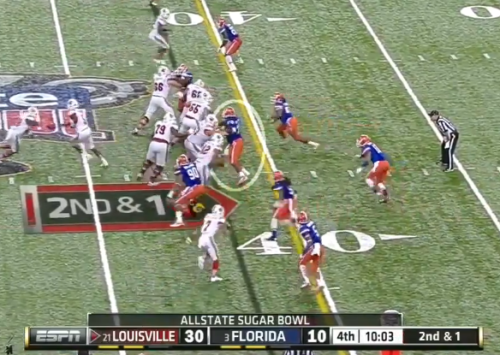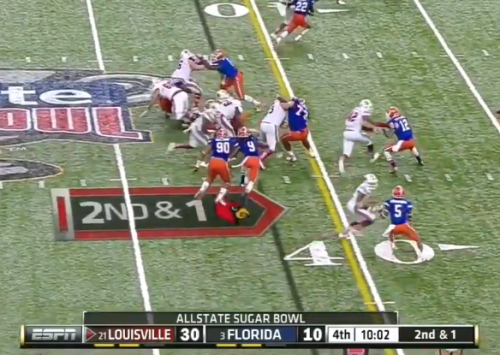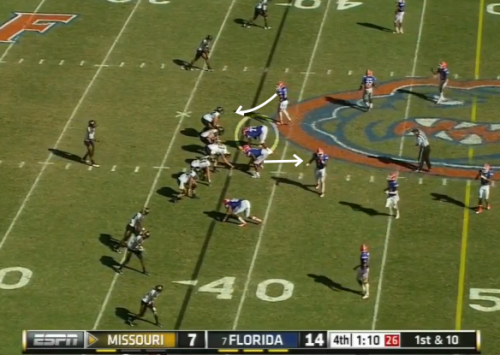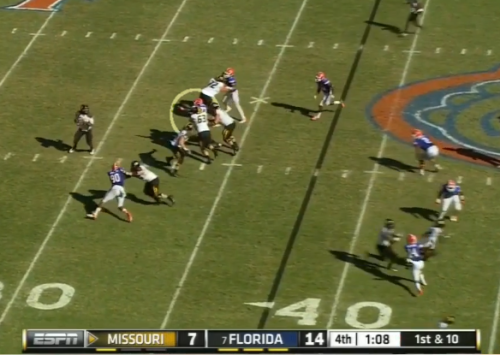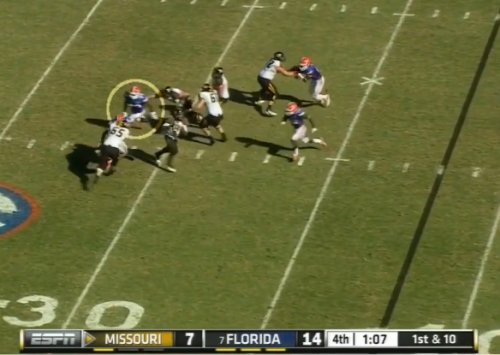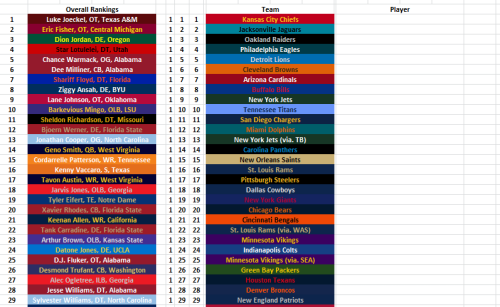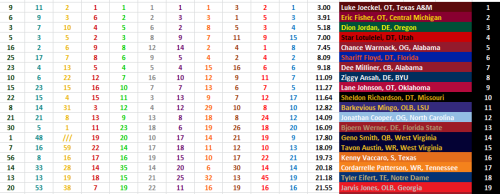This mock draft was written before the announcement of the Darrelle Revis trade, so keep that into consideration. Explanations stop at the conclusion of the fifth round, because explanations anywhere after are all going to be the same in effect: depth picks.
1. Kansas City Chiefs: Eric Fisher, OT, Central Michigan. The Chiefs’ need to protect the passer is undeniable this point. They paid big money for Alex Smith. It’s what he needs to succeed. Branden Albert’s future is cloudy at best and he may just be traded away before draft day. Eric Fisher makes sense because he is the best all-around offensive tackle in this draft, if not the best player. He’s extremely athletic and a mauler all at the same time. He truly does it all.
2. Jacksonville Jaguars: Geno Smith, QB, West Virginia. The Jaguars are in the midst of a massive overhaul of personnel and philosophy. Geno has the type A personality to provide leadership for an offense and team that definitely needs it. He’s the clear-cut favorite to be the first quarterback selected and deservedly so. New head coach Gus Bradley and new offensive coordinator Jedd Fisch have no connections to Blaine Gabbert or Chad Henne, so they’ll want to go their own direction.
3. Oakland Raiders: Star Lotulelei, DT, Utah. Reggie McKenzie and Dennis Allen inhibited a roster almost completely void of real talent a year ago. They’re still trying to clean up the mess and still have holes across the board. The Raiders are in a situation where they truly need to take the best player available and one who can provide an immediate impact. Star Lotulelei is the perfect anchor for a defensive rebuild from the inside out. He’s a scheme transcendent defensive tackle and an impact player.
4. Philadelphia Eagles: Luke Joeckel, OT, Texas A&M. Jason Peters and Todd Herremans may be fine offensive tackles in their own rights, but Joeckel’s talent trumps both. Chip Kelly having two bookend tackles who can free up the corner in the running game and allow space for his quarterback in the passing game is what keeps defensive coordinators up at night. Because of his consistent technique and footwork, Joeckel’s floor is as high as any prospect in this draft.
5. Detroit Lions: Ziggy Ansah, DE, BYU. If Ansah falls past the fifth pick in this draft, I’ll be surprised. The Lions got a first-hand look at his intoxicating athleticism and saw him thrive in the wide 9 technique come game time. Ansah is very inexperienced, and lacks the technique required of high impact pass rushers. He’s shown an ability to pick the game up quickly though, and the team that drafts him will bank on his ability to develop even further. His kind of athleticism doesn’t come around that often.
*Trade* The Miami Dolphins receive pick #6 (1st). The Cleveland Browns receive pick # 12 (1st), #54 (2nd), and #146 (5th).
6. Miami Dolphins (from CLE): Lane Johnson, OT, Oklahoma. After Jake Long walked in free agency, a big hole opened up at the blind side in Miami’s offense, one that Jonathan Martin cannot fill. While not as developed as Joeckel or Fisher, Lane Johnson’s potential is just as high. Johnson is blessed with impressive athleticism and natural strength. He’s a converted tight end, who is still learning the technique of the tackle spot. If he continues to develop on the track he is on now, the sky is the limit.
7. Arizona Cardinals: Dion Jordan, OLB, Oregon. Sam Acho has earned a starting role, but there is no impact outside linebacker on the roster outside of him. Jordan is as dynamic as linebacker prospects come. He lit up the combine, showcasing his size and athleticism. While he may not be a 18 sack pass rusher right away, the versatility he could give the Cardinals defense would be invaluable. Jordan can provide immediate impact in coverage while he builds on that frame to become a bigger, stronger rusher.
8. Buffalo Bills: Matt Barkley, QB, USC. This would be the first big surprise pick of the draft. Maybe it shouldn’t be though. The demand for quarterbacks is at an all-time high and trumps the supply of those that are ready. Debates on his value aside, Matt Barkley is a great fit for new head coach Doug Marrone’s rhythm passing game and steps into an offensive line that is strong enough to give him him clean pockets to work with. There are a number of directions the Bills could go with this pick.
9.New York Jets: Barkevious Mingo, OLB, LSU. If things fall this way for the Jets, this pick seems like a run to the podium type. The Jets defense lacks the teeth of previous year, mostly due to an inability to get after the quarterback. Mingo should be able to make the transition to a 3-4, where he can rush with more space to work with. He has almost no experience in coverage, but his explosive athletic ability can be put to good use rushing the passer. Coverage ability is gravy at this point.
10. Tennessee Titans: Dee Milliner, CB, Alabama. The Titans defense gave up the most points in the league last year, so the best defensive player on the board makes the most sense. Dee Milliner can pair with Jason McCourty and drastically improve Tennessee’s pass defense. Milliner is widely regarded as the draft’s best cornerback and for good reason. With a combination of instincts, technique, athleticism, and ball skills, he really does it all in coverage.
11. San Diego Chargers: Xavier Rhodes, CB, Florida State. With the big three offensive tackles off the board, the Chargers can turn to another area of need and fill it with Xavier Rhodes. Rhodes fits the profile of the most sought after cornerbacks in today’s league. He’s big, physical, and incredibly athletic. He’s a great fit in John Pagano’s defense and can help shore up a pass defense that needs to get younger and lacks a shutdown corner on the boundary.
12. Cleveland Browns (from MIA): Tavon Austin, WR, West Virginia. Things are looking up in Cleveland, but the passing game still has unanswered questions. Tavon Austin could add a dimension to the Browns offense that it desperately needs. The plan to make it happen is simple: get the ball in Austin’s hands in whatever way you can. He has the instincts and vision of a running back combined with a quick cut ability to make defenders miss in space and an explosive burst to break free and go the distance on any snap.
13. Tampa Buccaneers: Tank Carradine, DE, Florida State. Where the Bucs’ pass rush will come from remains a mystery at this point. Adding a stud pass rusher like Carradine would go a long ways toward solving that mystery, while replacing the production Michael Bennett gave the defense. If Carradine’s medical examinations come out with a positive prognosis, he deserves to be drafted higher than Bjoern Werner because he’s more impressive physically and is an even more menacing pass rusher.
14. Carolina Panthers: Sharrif Floyd, DT, Florida. The Panthers have been a revolving door at defensive tackle since Kris Jenkins left town. Floyd is no Jenkins, but he has a knack for making plays in the backfield that is sure to catch the eye of any GM looking for production from the middle. Though he needs technical refinement, he’s a great fit for Sean McDermott and Ron Rivera up front. The Panthers could also consider Sheldon Richardson with this pick, who I think is a superior prospect.
15. New Orleans Saints: Kenny Vacarro, S, Texas. As the Saints try to overhaul one of the worst defenses in recent memory, they can’t go wrong adding a swiss army knife on the back end like Kenny Vacarro. He brings value as a corner that can walk up into the box and provide run support. He can also man up with tight ends or play over the top as a bracket safety. Getting younger at the strong safety spot is a big need for the Saints as Roman Harper sees his way out of the league. Vacarro is the man for the job.
16. St. Louis Rams: Chance Warmack, OG, Alabama. The Rams’ need for an offensive guard is painfully obvious at this stage. If the draft board hands Chance Warmack to Les Snead, he’ll giggle himself to sleep at night. It’s not impossible though, considering the relative value of the position. Warmack is an immediate contributor, with the ability to maul defenders as a run blocker. Sliding him into the left tackle spot next to Jake Long will give Sam Bradford no excuses anymore.
17. Pittsburgh Steelers: Jarvis Jones, OLB, Georgia. The Steelers’ defense is aging less like wine and more like milk these days. Jarvis Jones can provide an infusion of youth into a pass rush that has come to a grinding halt. Though Jones may not be the dynamic pass rusher his numbers suggest, they are tough to argue against. He consistently produced at a high level in the country’s best conference, which will be enough to get a team looking a pass rusher to bite plenty early.
18. Dallas Cowboys: Jonathan Cooper, OG, North Carolina. If you’re going to give Tony Romo the contract that Jerry Jones did, you better start protecting him. Jonathan Cooper might be as athletic an offensive guard as we have ever seen. He also has the wherewithal to slide over to center if asked to. He’s a stout pass blocker who can keep Romo’s pocket intact from the middle, while providing a dynamic blocking element in the running game. His range to the sideline and downfield is unmatched.
19. New York Giants: D.J. Fluker, OT, Alabama. Jerry Reese has never drafted an offensive lineman in the first round as general manager, but if there were one to make him pull the trigger it would be D.J. Fluker. The time is right, as David Diehl is no longer starting quality. Fluker has the length to make up for heavy feet as a pass protector and can be mauling force up front in the running game. Andre Brown and David Wilson would certainly love to run through the holes Fluker can create.
20. Chicago Bears: Tyler Eifert, TE, Notre Dame. A new general manager and a new head coach are in town. Gone are the days of the scrub tight end. By pairing Eifert with Martellus Bennett, Jay Cutler would have arguably the most dynamic group of receivers in the league. Eifert provides another big redzone target but also has the ability to stretch the defense in the seam. His ability to highpoint the football with his soft hands is something that you just cannot teach a tight end.
21. Cincinnati Bengals: Arthur Brown, LB, Kansas State. The re-signing of Rey Maualuga shouldn’t be an indication of the Bengals’ draft plans, because he shouldn’t have a starting job. Arthur Brown is the best non-pass rushing linebacker in the class, with the ability to play the Mike and Will linebacker spots in a 4-3. He’s a superb athlete who sheds blocks and is a sure tackler when he gets to the ball. He also plays faster than he times with a quick read and react and natural instincts for the position.
22. St. Louis Rams: Jonathan Cyprien, S, Florida International. The Rams just missed out on Kenny Vacarro at pick 16, but Cyprien is one hell of a consolation prize. Starting Darian Stewart and Rodney McLeod on your defenses back end in a division with Russell Wilson and Colin Kaepernick is the quickest way to the cellar. Cyprien is a do-it-all safety with a nose for the football and the athleticism to close on it in the blink of an eye. He can be a game changer for the Rams defense.
23. Minnesota Vikings: Sheldon Richardson, DT, Missouri. The Vikings chopping a year off the contract of Kevin Williams has put the writing on the wall. Rick Spielman wants to keep the youth movement going on the defensive side of the ball. While Richardson wouldn’t slide into a starting spot at the three technique as a rookie, he would provide a dynamic pass rush specialist in passing situations and a strong rotational player. He’s actually my number one overall player, so I think it would be a brilliant pick even if it didn’t pay dividends immediately.
24. Indianapolis Colts: Bjoern Werner, OLB, Florida State. Bjoern Werner is a 4-3 left defensive end in my book, but says he’s gotten more interest at a linebacker position. The Colts are a great landing place in that case, considering they haven’t found that dynamic pass rusher since their switch to a 3-4. Werner likely will never be a coverage specialist, but rushing from a two point stance may allow him the space to convert speed to power while making use of that quick first step.
25. Minnesota Vikings: Manti Te’o, ILB, Notre Dame. It’s no secret that the Vikings have invested a large amount of resources into Te’o in the pre-draft process. It seems like too much time spent to simply be a smokescreen or sending out feelers. With Jasper Brinkley walking in free agency, the Vikings have a huge hole at the Mike linebacker spot. Te’o can step in and start on day one without having to be the quarterback of the defense. That is Chad Greenway. It’s tough to ask for a better landing spot than Minnesota for Te’o.
26. Green Bay Packers: Datone Jones, DE, UCLA. This pick has almost become cliché at this point, but the fit is just too perfect. Datone Jones is a movable chess piece with the versatility to line up anywhere across the defensive line. Dom Capers’ dynamic front seven is the perfect landing spot for a player with the skillset of Jones. He’s a freak athlete with size and power. If his technique develops as a pass rusher to enhance his natural ability, he can get after quarterback from the inside as well as anyone.
27. Houston Texans: Cordarrelle Patterson, WR, Tennessee. It’s put up or shut up time for Matt Schaub and the Texans offense. Patterson would add a dimension to the passing game that currently doesn’t exist. The pressure that Andre Johnson puts on defenses would give Patterson space to operate as a route runner. He could provide an outlet for Schaub underneath. Once he gets the ball in his hands, he has the explosive burst and quick cut ability to elude defenders and pick up big yardage.
28. Denver Broncos: Sylvester Williams, DT, North Carolina. Despite the signing of Terrance Knighton and re-singing of Kevin Vickerson, the Broncos are in need of true impact playmaker from the inside. Sylvester Williams may be one of the most underrated prospects in this class. He explodes off the ball and makes plays in the backfield on a consistent basis. If he can be taught how to harness and make best use of his size and raw power, he can be a dominant force from the inside.
*Trade* The Arizona Cardinals receive pick #29 (1st). The New England Patriots receive picks #38 (2nd), #103 (4th), and a future 4th.
29. Arizona Cardinals: Menelik Watson, OT, Florida State. Menelik Watson fits what Bruce Arians is looking for in an offensive tackle. He’s an impressive enough athlete with uncommon raw power. Even though he may be a developmental offensive tackle as a whole, he has the drive block ability for a power running game on day one. It’s a risky selection, but his upside is going to get a general manager to make a bold move in the first round.
30. Atlanta Falcons: Jamar Taylor, CB, Boise State. With the departure of Brent Grimes and age creeping up on Asante Samuel, the Falcons have a need for an impact cornerback. They’re in the right place in the draft to get one. Taylor is a physical, scrappy cornerback with the anticipation and instincts for zone coverage. He’s also plenty reliable as a tackler, where he plays much bigger than his size would lead to you to believe.
31. San Francisco 49ers: Jesse Williams, DT, Alabama. This is what I would call the rich getting richer. Jesse Williams is the perfect nose tackle for the 49ers front seven. He can clog up space in the middle to keep their stud inside linebackers free, while providing enough athleticism and energy to make enough plays of his own. The brute strength and consistent technique Williams has at the point of attack should be enough to ensure a first round pick.
32. Baltimore Ravens: Robert Woods, WR, USC. Robert Woods has often been the forgotten man in such a talented wide receiver class, but I think he could have a chance to sneak into the first round. While other receivers like Keenan Allen and DeAndre Hopkins may be turning teams off with off-field antics, Woods could find his way to go this high. He’s also a great fit for Baltimore. He’s the perfect yin to Torrey Smith’s yang. He can consistently get open underneath with sharp route and provide a redzone target.
33. Jacksonville Jaguars: Damontre Moore, DE, Texas A&M. The Jaguars’ lack of pass rushing production a year ago is well documented. Moore was extremely productive for the Aggies over the course of two seasons. He has positional versatility with experience in a 3-4 and 4-3 defense. He could be the perfect fit for Gus Bradley’s LEO position, where he can stand up and use space to generate power as a rusher. Moore’s motor is largely unmatched among pass rushing prospects. Now it’s all about technical development.
34. San Francisco 49ers: Eric Reid, S, LSU. The 49ers’ need for a safety is pretty obvious at this point. Going into the season with Donte Whitner and Craig Dahl at the backend is asking for trouble. Eric Reid is a great fit in Vic Fangio’s defense. He can patrol over the top and break on the football quickly. He’s a strong tackler and a physical safety that can be relied upon.
35. Philadelphia Eagles: E.J. Manuel, QB, Florida State. There isn’t a quarterback who truly fits Chip Kelly’s offense on the roster right now. E.J. Manuel is the perfect fit and I believe the Eagles will do whatever they need to do in order to snag him. He’s always a threat to run, which opens things up for Kelly’s offense and makes it tick. If his mechanics can be cleaned up and accuracy improved at the same time, he could be the long-term answer. Those are big if’s though.
36. Detroit Lions: DeAndre Hopkins, WR, Clemson. Martin Mayhew has drafted a receiver in the second round each of the last two years. While Ryan Broyles has shown some promise, Titus Young is long gone. DeAndre Hopkins could fill out that corps of pass catchers with his ability to separate as a route runner and attack the football in the air. How teams view the combine hotel room incident will be important for his draft position.
37. Cincinnati Bengals: Matt Elam, S, Florida. The Bengals can continue to infuse their defense with young talent and would be wise to upgrade at strong safety. Mike Zimmer’s defense is a great landing spot for Elam. He’s an aggressive safety with a penchant for the knockout blow. He also provides solid run support. If he can become a more disciplined player as a whole, he can be an immediate impact player.
38. New England Patriots (from ARI): Justin Hunter, WR, Tennessee. Justin Hunter’s height and athletic ability will be enough to make someone pull the trigger early, maybe even in the first round. After trading back to recoup some draft picks, the Patriots can add a receiver with the ability to take the top off the defense that they haven’t had since Randy Moss left town.
39. New York Jets: Ryan Nassib, QB, Syracuse. The days left for Mark Sanchez as the Jets’ starter are numbered and the offense needs a new direction completely. Nassib is a decisive quarterback who can run a rhythmic passing game with pinpoint accuracy in the short and intermediate areas. His footwork and trajectory of the deep ball need lots of work, but he’s not going to last long on day two. That’s if he’s not a first round pick to start with.
40. Tennessee Titans: Larry Warford, OG, Kentucky. The Titan’s offensive philosophy is pretty clear: they want to pound the rock and use it to set up the pass. Adding Andy Levitre in free agency was a big step and adding a bulldozer like Larry Warford is another. Warford has surprising athleticism for a mammoth guard and can create movement up front and open holes for the running backs they’re so heavily invested in.
41. Buffalo Bills: Kevin Minter, ILB, LSU. Buddy Nix may go back to the well on another LSU linebacker. Minter fits what new defensive coordinator Mike Pettine wants to do on defense. He’s versatile enough to handle inside duties in 4-3 and 3-4 looks while providing value as a blitzer from the inside. This pick will heavily depend on how the new staff views Kelvin Sheppard’s fit moving forward.
42. Miami Dolphins: Desmond Trufant, CB, Washington. The fall for Trufant ends here. Sean Smith skipped town at the first sight of free agency and what’s left behind him can be upgraded. Brent Grimes was brought in, but his long-term health is still a question mark. Trufant can step right in and contribute immediately with his high competitiveness and ability to press receivers before utilizing his athleticism to run with them.
43. Tampa Bay Buccaneers: Johnthan Banks, CB, Mississippi State. The Bucs improved their secondary by pairing up Mark Barron with Dashon Goldson in free agency, but the cupboard at cornerback is bare. Banks had a mildly disappointing senior season and has question marks about his athleticism. Even so, he’s a great fit for the Buccaneers’ zone scheme, is a high character guy, and has terrific ball skills.
44. Carolina Panthers: Darius Slay, CB, Mississippi State. The Panthers were forced to cut Chris Gamble in the off-season to free up some cap space. That leaves a pretty large hole in an already average secondary which faces Drew Brees and Matt Ryan in a fourth of their season. Slay is a superb athlete with fluid hips to turn and run is one of the underrated cornerbacks of this class.
45. San Diego Chargers: Terron Armstead, OT, Arkansas-Pine Bluff. In order to slow the regression of Philip Rivers and then hopefully get him to trend in the right direction, the Chargers need to do a much better job of protecting him. Terron Armstead is one of the most athletic tackles anyone has ever seen and a perfect fit for San Diego’s new zone blocking scheme. In my personal opinion, his learning curve isn’t as steep as advertised.
46. St. Louis Rams: Alec Ogletree, OLB, Georgia. Jeff Fisher has proven to have no qualms about taking a prospect with character concerns. Even though Ogletree is strictly a Will linebacker, which is JoLonn Dunbar’s spot, his dynamic athletic ability and penchant for the big play in coverage and pursuit is something the Rams defense desperately needs. If he can keep his nose clean off the field and quickly develop his technique on it, he can be among the league’s best.
47. Dallas Cowboys: Margus Hunt, DE, SMU. This feels like a Jerry Jones type pick to me. Margus Hunt’s athleticism is off the charts. He also projects as a moving piece player up front, the kind that a defensive coordinator like Monte Kiffin could make good use of. Whether the Cowboys line up in an odd or even front, Hunt can play a role. While there is inherent risk in drafting Hunt, the upside he has will see him come off the board much earlier than most expect.
48. Pittsburgh Steelers: Keenan Allen, WR, California. The Steelers offense sputtered for most of the season last year and they need to get Ben Roethlisberger back on track. The outlook for the wide receiver situation is cloudy at best. Mike Wallace is no longer in town and Emmanuel Sanders will be in a contract year. Keenan Allen can provide a security blanket and red zone target for Big Ben with his ability to elude press coverage and highpoint the football.
49. New York Giants: Alex Okafor, DE, Texas. The Giants defense finished a putrid 31st in the league last season, due in large part to their inability to get after opposing quarterbacks. While Alex Okafor isn’t a phenomenal athlete, he has some technician-like qualities as a rusher with undeniable production for the Longhorns. He also can bring value as an interior pass rusher on third downs.
50. Chicago Bears: Khaseem Greene, OLB, Rutgers. The youth movement in the Bears linebacking corps has begun. Signees James Anderson and D.J. Williams aren’t guaranteed to be long-term answers and adding depth in a must anyways. Greene is on the small end of the linebacker spectrum, but it makes him a more dynamic Will linebacker. He has a penchant for the big play and is smooth in coverage. Consistency as a tackler and taking on blocks needs to be developed.
51. Washington Redskins: D.J. Hayden, CB, Houston. With the 31st ranked pass defense a year ago, it’s tough to argue against any pick the Redskins make that addresses the secondary. D.J. Hayden is one of the most overlooked prospects in the class and has a miraculous story from his senior season. He’s a fit for Redskins with the ability to play press or off and the athleticism to run with receivers. When he can get physical with route runners, he’s a much more effective cornerback.
52. Minnesota Vikings: Da’Rick Rogers, WR, Tennessee Tech. Percy Harvin being shipped out of town opened up a void in a group of pass catchers that was already poor. Greg Jennings was a terrific signing and a good fit. Da’Rick Rogers is the receiver the Vikings are looking for to fill out the group. He’s big, physical, and can muscle cornerbacks from the football. What gets overlooked is his explosive athleticism. He won’t be burning past cornerbacks for deep balls anytime soon, but his legs have some real pop in them.
53. Cincinnati Bengals: Giovani Bernard, RB, North Carolina. For better or worse, the Bengals offense is based around their ability to run the ball. As steady As BenJarvus Green-Ellis may be, he’s not a threat to pick up big yardage with the ball in his hands. Giovani Bernard has the vision and foot quickness to run from traditional sets as well as the pass catching ability to provide a target in the passing game. He’s the perfect lightning to Green-Ellis’ (maybe not so heavy) thunder.
54. Cleveland Browns (from MIA): Corey Lemonier, OLB/DE, Auburn. As the Browns transition to a 3-4 defensive scheme, the most crucial component will be their edge pass rushers. They brought in free agent Joe Kruger, but you can truly never have enough. Lemonier brings an explosive first step, a high motor, and an ability to speed rush around the corner that translate well to a two point stance. He has experience in the 4-3, which means he brings value for even fronts as well.
55. Green Bay Packers: Eddie Lacy, RB, Alabama. Ted Thompson is notoriously stubborn about bringing in top talent at the running back position. He may finally pull the trigger on a running game investment though, and Eddie Lacy is the perfect fit. His vision is relatively poor, but the Packers’ passing game spreads defenses wide enough it shouldn’t be a big issue. This allows Lacy to get up to speed and through holes and utilize his power and nimble feet in space.
56. Seattle Seahawks: Johnathan Hankins, DT, Ohio State. The Seahawks have been stockpiling talent on the defensive line, so why stop now? Hankins is just too much value at the end of the second round to pass up and can combine with Brandon Mebane to be a disruptive duo up front. Hankins’ athletic ability is ridiculous considering his size and weight. He’s an underrated playmaker. His play is plagued by motor and effort issues though.
57. Houston Texans: Tyler Wilson, QB, Arkansas. It’s time to start looking for an upgrade over Matt Schaub to ensure that this team hasn’t plateaued. A late second round pick spent on a guy like Tyler Wilson is a bargain. Wilson can wait in the wings and develop while Schaub is still taking snaps. If given time, Wilson may be able to weed out some of the bad habits he picked up playing for an awful Arkansas team as a senior.
58. Denver Broncos: D.J. Swearinger, S, South Carolina. The failures of the secondary were eventually the undoing of the Broncos in the post-season. D.J. Swearinger can bring an aggressive and fearless force on the backend of that defense. In order to maximize his effectiveness as a professional safety, Swearinger needs to find a balance in his aggression level that allows him to maintain proper discipline. If that doesn’t happen, he’s going to be a magnet for penalties.
59. New England Patriots: Quinton Patton, WR, Louisiana Tech. Would the Patriots really spend both of their first two picks on wide receivers? Looking at the wide receivers under contract, it’s something that should be considered. Quinton Patton in the late second round is too much value to pass up on. Patton is a pro-ready receiver in every sense of the term. He’s a receiver who runs incredibly precise routes and the kind of receiver that Tom Brady could develop an instant rapport with.
60. Atlanta Falcons: Sam Montgomery, DE, LSU. The ability to consistently apply pressure on opposing QB’s has been something the Falcons defense hasn’t been able to do in recent seasons. Osi Umenyoria is not a long-term answer and may not even be a short-term one. Sam Montgomery is a physical overpowering defensive end made for the 4-3. He combines just enough athleticism and motor to make him an impact defender. If the Falcons can clean up his get off and slow things down for him, he may succeed.
61. San Francisco 49ers: Zach Ertz, TE, Stanford. Ertz is consistently mocked to the 49ers, but for good reason. Stylistically, he’s the perfect replacement for the departed Delanie Walker. Of course, head coach Jim Harbaugh coached him at the college level and is familiar with Ertz. The 49ers offense can accentuate his strengths and won’t ask him to be a mauling blocker up front.
62. Baltimore Ravens: Dallas Thomas, OT, Tennessee. The Ravens offensive line is in limbo and it remains to be seen what they may do to address it. It all depends on how they view Kelechi Osemele and Michael Oher in terms of position. Either way, Dallas Thomas showed his versatile by excelling at the guard spot as a senior, while he may be even better suited on the edge. He has impressive feet and is a smart player who can contribute in some way.
63. Kansas City Chiefs: Sio Moore, LB, Connecticut. Derrick Johnson isn’t getting any younger and has no viable running mate on the inside. Sio Moore’s skills translate to multiple positions, which will allow the Chiefs to utilize him in more than one capacity. He brings fluid footwork and hips in coverage. He’s a proven pass rusher who can make an impact as a blitzer. Moore is an aggressive linebacker with the ability to close on the ball quickly.
64. Jacksonville Jaguars: Justin Pugh, OG, Syracuse. Outside of Eugene Monroe, every spot on the Jaguars’ offensive line could use an upgrade. Pugh can slide to the inside and be a technical blocker with a strong upper body and the nimble feet to work laterally and leverage open holes as a run blocker. Pugh has the versatile skillset to start at a number of offensive line positions as a rookie.
65. Detroit Lions: Kyle Long, OT/OG, Oregon. The Lions offense is in flux at the moment and has hole everywhere. While he may be more of a project than most want to admit, Kyle Long is going to be valued higher because of his natural athleticism and strength. He could legitimately project to either guard spot or right tackle for the Lions, depending on how they view him as a prospect.
66. Oakland Raiders: Tyler Bray, QB, Tennessee. Even though the Raiders acquired Matt Flynn, they’re still in need of competition at the quarterback spot. Flynn would certainly get the starting nod on day one, but Bray is a high upside developmental quarterback with impressive tools. He can use his time behind Flynn to develop his release, footwork, and decision making within the offense.
67. Philadelphia Eagles: Jordan Poyer, CB, Oregon State. After seeing Dominique Rodgers-Cromartie and Nnamdi Asomugha out of town, the Eagles really haven’t brought in any long-term answers at the cornerback position. Poyer has the potential to be a game-changing cover guy with a knack for getting his hands to the football and the natural instincts for zone coverage.
68. Cleveland Browns: Blidi Wreh-Wilson, CB, Connecticut. The Browns will certainly be eyeing another cornerback to pair with Joe Haden at some point in the draft. Wreh-Wilson has the quick feet and body flexibility to be a terrific man coverage cornerback. It’s all going to be about technical development, as he wasn’t often asked to sit in a backpeddle for the Huskies.
69. Arizona Cardinals: Zac Dysert, QB, Miami (OH). Nobody in that building can truly believe Carson Palmer is the answer for any longer than a year. Bruce Arians surely wants to go out and find his own quarterback, one he can groom into his system. I can’t think of a better fit than Zac Dysert. He’s a big, mobile guy with impressive accuracy downfield. With a year to wait in the wings and learn, he could become a special quarterback.
70. Tennessee Titans: Kawann Short, DT, Purdue. The stockpiling of defensive tackle talent continues in Tennessee. Short can provide a gap-shooting presence from the inside and won’t have any excuse for the motor issues he’s shown with the Titans’ ability to rotate up front. If Short ever puts it all together he could be highly impactful defensive tackle.
71. Buffalo Bills: Markus Wheaton, WR, Oregon State. The Bills group of wide receivers is pretty mediocre and has no depth whatsoever. Markus Wheaton is an absolute steal if he’s sitting on the board in the third round. He has speed to burn and separates with ease out of his cuts. The speed he plays the game at is uncommon and he has the kind of ability that keeps defensive coordinators up at night.
72. New York Jets: Travis Kelce, TE, Cincinnati. Travis Kelce has the ability to replace Dustin Keller in the Jets’ offense and then some. The only blip on Kelce is the mysterious year-long suspension, which means that whoever drafts him will need to do their homework. Kelce is a powerful run blocker and is deceptively athletic as a pass catcher. He can impact the game in a high number of ways.
73. Tampa Bay Buccaneers: Stedman Bailey, WR, West Virginia. Stedman Bailey is the perfect complement to Mike Williams and Vincent Jackson. He has the versatility to work out of the slot or from the outside. There’s not much Bailey doesn’t catch. He’s a polished receiver in every aspect of his game and plays much bigger than he is.
74. San Francisco 49ers (from CAR): Jamie Collins, OLB, Southern Mississippi. The 49ers picked Cam Johnson in last year’s draft, but that hasn’t worked out so well after a single season. It’s a luxury pick for sure, but San Francisco can draft Jamie Collins and develop him along while adding another supremely athletic pass rusher into the fold.
75. New Orleans Saints: John Jenkins, DT, Georgia. With the switch to a 3-4 defensive scheme underway, the Saints need space eaters inside. John Jenkins and Akiem Hicks can accomplish that. Jenkins also has the light feet and athleticism to spotlight as a five technique as well. Weight and concerns about his technique and lack of physicality may seem him fall this far in the draft.
76. San Diego Chargers: Andre Ellington, RB, Clemson. Ryan Mathews has proven that he can’t stay healthy and Danny Woodhead is no more than a niche back. Andre Ellington is a perfect fit for the zone blocking scheme. He also brings a ton of value as both a pass catcher and pass blocker, where he can take some of the pressure off the shoulders of Philip Rivers.
77. Miami Dolphins: Ryan Swope, WR, Texas A&M. Though adding a wide receiver this early may be somewhat of a luxury, the connection between Swope, Ryan Tannehill, and offensive coordinator Mike Sherman may be all the difference. Swope has the versatility to line up in the slot or outside and is as reliable as they come. Combine that with an ability to run crisp routes and long speed and you’re looking at an underrated wide receiver. If he can find that chemistry with Tannehill again, look out.
78. St. Louis Rams: Phillip Thomas, S, Fresno State. It seems both smart and realistic for the Rams to double up on safeties. If they are to draft Jonathan Cyprien in the first, it would give them flexibility because of his versatility. Phillip Thomas would bring a ballhawk safety into the mix. He hauled in eight interceptions as a senior at Fresno State. He’s very inconsistent as a whole though and has some effort question marks.
79. Pittsburgh Steelers: Johnathan Franklin, RB, UCLA. The Steelers finished 26th in the league in rushing last season. Having a one-dimensional offense really held them back. Johnathan Franklin is a high IQ football player who has the natural instincts for the position. He follows blocks as well as any back and brings enough value in passing situations to warrant a second day draft pick.
80. Dallas Cowboys: David Amerson, CB/S, North Carolina State. Morris Claiborne and Brandon Carr have things taken care of on the boundaries, but the outlook over the top is unclear. David Amerson got scorched a number of times as a junior and needs a transition to safety, where he can break on the football and use his elite ball skills to bring down interceptions.
81. New York Giants: Jordan Reed, TE, Florida. The Giants need to add more talent around Eli Manning in order to avoid wasting his best years. Jordan Reed could potentially add an element to the Giants offense that hasn’t existed with Eli under center. Reed is a joker tight end who can move all over the field and provides run after catch ability that most tight ends can only dream about.
82. Miami Dolphins: Quanterus Smith, DE, Western Kentucky. Where Smith falls in this draft will be somewhat dependent on how teams view his surgically repaired ACL. The impact he made on the field as a senior is undeniable, completely taking over multiple games, including one against Alabama. He can provide another pass rushing threat to the Dolphins defense once he’s back to 100%.
83. Minnesota Vikings: Leon McFadden, CB, San Diego State. I don’t envision the release of Antoine Winfield will change the Vikings draft plans at cornerback drastically. They needed one either way. McFadden is a terrific fit in the cover 2. He’s an instinctive zone cornerback who competitively plays the ball in the air and is a sufficient tackler. He could be viewed as a slot specialist or fit for the boundary.
84. Cincinnati Bengals: Brian Winters, OG/OT, Kent State. The Bengals could continue to load up their offensive line and further strengthen their running game selecting Winters. He’s a strong and nasty run blocker who can create movement up front. They could potentially view him as either an offensive guard or a right tackle.
85. Washington Redskins: Bacarri Rambo, S, Georgia. An upgrade at the free safety position could do a lot of good for a poor Redskins secondary. Rambo could be that guy. While not the most physical safety in the world, the thrives roaming over the top. He’s able to anticipate throws and gets early breaks on the ball as a result. He has the ball skills to be productive hauling in interceptions as well.
86. Indianapolis Colts: Barrett Jones, C, Alabama. Neither Samson Satele nor Mike McGlynn instill confidence anyone. Barrett Jones has the versatility to realistically play almost every position across the line. He could lead Pep Hamilton’s offense from the center spot because he’s a leader and is incredibly smart. While he’s not a phenomenal athlete or a mauler up front, he can improve the Colts’ line.
87. Seattle Seahawks: David Bakhtiari, OT/OG, Colorado. Outside of Max Unger and Russell Okung, the rest of the Seahawks offensive line could be improved upon. Bakhtiari could fit at either right tackle or either guard spot. He’s a quick-footed blocker who can sustain a block about as long as anyone. He may be one of the most underrated prospects in the draft.
88. Green Bay Packers: Brian Schwenke, C, California. Jeff Saturday was only a hold-over at the center position, and he couldn’t even last the whole season. Brian Schwenke can come in and lock down the starting job. He’s an extremely mobile center who does impressive work in space. He fits what the Packers want to do offensively.
89. Houston Texans: Brandon Williams, DT, Missouri Southern State. The Texans have yet to bring in an anchor nose tackle since their switch to the 3-4 scheme. Williams has the strength, size, and leverage to eat up blocks on the inside. He may also have enough athleticism and motor to bring some value on passing downs.
90. Denver Broncos: John Simon, DE/OLB, Ohio State. After the Elvis Dumervil mishap, the Broncos must bring in another pass rusher. John Elway could view Simon as the type of rusher that can be groomed into that role. Simon is a strong, relentless rusher with surprisingly quick and efficient moves. He lacks ideal size and may be limited in the end by that.
91. New England Patriots: Michael Buchanan, DE, Illinois. Chandler Jones lived up to all the hype and then some as a rookie, but he’s really the Patriots’ only impact pass rusher. Michael Buchanan had a disappointing senior season, but if he can get back to the level he played at as a sophomore he can contribute. He stills needs to develop his frame and become a stronger player as a whole.
92. Atlanta Falcons: Vance McDonald, TE, Rice. Tony Gonzalez is coming back for one more crack at the Lombardi, but it seems safe to say this is his last season. Vance McDonald is a supremely athletic tight end who needs to develop his pass catching skills and learn blocking technique. He can do that behind the hall of famer for a season before he’s expected to contribute.
93. San Francisco 49ers: Robert Alford, CB, Southeastern Louisiana. With the number of draft picks the 49ers have, they’ll surely be making some luxury picks. Robert Alford has uncommon athleticism, but he’s plagued by technique issues. He can contribute immediately as a punt returner for the 49ers while developing his game on the defensive side of the ball.
94. Baltimore Ravens (Compensatory): Kiko Alonso, ILB, Oregon. Nobody is going to come in as a rookie and replace Ray Lewis. Kiko Alonso isn’t that type of linebacker at all, but he can bring a physical and fearless linebacker into the fold. Alonso thrives as a blitzer and in pass coverage. He’s a fantastic athlete who flies to the football. He’s certainly not a fit for everyone though. His undisciplined style of play and off the field issues are a concern.
95. Houston Texans (Compensatory): Chase Thomas, OLB, Stanford. Pass rushers have been leaving in free agency in recent years, so the Texans need to restock that part of their defense. Chase Thomas is a heavily experience and well-polished pass rusher who is suited for the 3-4 defense. He brought consistent production at Stanford and even a fraction of that would be good news for the Texans.
96. Kansas City Chiefs (Compensatory): Josh Evans, S, Florida. On a Florida defense full of talent, Josh Evans was the overlooked man. He reads the intentions of quarterbacks well to break on the ball as a centerfield type safety. He’s a good fit to pair with Eric Berry and shore up the backend of the Chiefs defense.
97. Tennessee Titans (Compensatory): Cornelius Washington, DE, Georgia. Derrick Morgan is starting to come into his own as a pass rusher, but free agent addition Kamerion Wimbley was a disappointment. Pass rush help is needed, and Washington is a great fit. He can provide a pass rush specialist off the edge, utilizing a quick first step and ability to convert speed to power.
98. Jacksonville Jaguars: Shamarko Thomas, S, Syracuse. Shamarko Thomas is the kind of player new head coach Gus Bradley should have his eye on. Thomas is an aggressive and physical safety who is strong in run support and can run with tight ends in man coverage. Height issues and concussion concerns will cause his to drop though.
99. Kansas City Chiefs: William Gholston, DE, Michigan State. Tyson Jackson never lived up to his draft pick and he’ll hit free agency after this season. Gholston is a perfect fit for the 3-4 defense where he can utilize his natural strength from the inside. He should be able to press the pocket as a pass rusher and occupy blockers in the running game.
100. Oakland Raiders: Gavin Escobar, TE, San Diego State. The Raiders haven’t had an impact pass-catching tight end in recent memory. They’ve invested in Matt Flynn and need to put some weapons around him. Escobar is an athletic tight end who can press the seam and highpoint the football. He provides almost no value as a blocker and needs to get stronger and more physical though.
101. Philadelphia Eagles: Shawn Williams, S, Georgia. Despite bringing in a haul of defensive backs in free agency, the Eagles need to keep bringing in young talent. Shawn Williams is a proven leader from the backend of a defense and has the physicality and tackling ability teams look for in a strong safety.
102. Minnesota Vikings (from DET): Lavar Edwards, DE, LSU. The Vikings’ three top pass rushers are all free agents in 2014, so adding Lavar Edwards is a way to keep an eye on the future and provide depth. Edwards isn’t a dynamic edge rusher, but is a consistent player and can even slide inside to rush from the interior in pass rushing situations.
103. New England Patriots (from ARI): Tyrann Mathieu, CB, LSU. If there’s any head coach who can keep Mathieu out of trouble and keep him motivated, it’s Bill Belichick. Mathieu brings value as a slot cornerback and as a punt returner. He has a knack for striping the football and making big plays. He needs to improve his technique and will always be limited by a lack of ideal size.
104. Cleveland Browns: Duke Williams, S, Nevada. T.J. Ward is the real deal for the Browns, but they could stand to upgrade the other safety spot or add depth at the very least. Duke Williams is a heavy-hitting safety with great closing speed to break on the ball. His off-the-field concerns will need to be checked out though.
105. Buffalo Bills: David Quessenberry, OT/OG, San Jose State. If the Bills are to draft Matt Barkley, it will be very important to shore up the interior offensive line to keep pockets clean. David Quessenberry is an extremely versatile blocker who may project best at offensive guard. He’s a fundamentally sound blocker who may be able to step into a starting role as a rookie.
106. New York Jets: Aaron Dobson, WR, Marshall. Whoever quarterbacks the Jets in the coming years needs to have more weapons to work with. It’s tough to pass on a guy as physically talented as Aaron Dobson at this point. His senior season was a disappointment in terms of production and consistency, but his upside is as high as anyone’s.
107. Tennessee Titans: Tony Jefferson, S, Oklahoma. After the poor season Michael Griffin had a season ago, the Titans should consider bringing in a safety at some point in the draft. Tony Jefferson does his best work breaking on the ball from the back end of the defense. He’s still too inconsistent of a tackler to be a starter early on.
108. Carolina Panthers: Terrance Williams, WR, Baylor. Age is starting to catch up to Steve Smith and the Panthers could make good use of a field-stretching wide receiver. Williams can get behind defenses on the nine route and produced at a high level at Baylor. He needs to improve his route tree and pass catching technique for sustained success in the league though.
109. New Orleans Saints: Reid Fragel, OT, Ohio State. The Saints could use upgrades at both tackle spots and need depth at the very least. Reid Fragel has only been playing tackle for a single season, but really took to the position well. His upside is extremely high considering his impressive athleticism and nasty demeanor.
110. San Diego Chargers: Alvin Bailey, OG, Arkansas. Louis Vasquez leaving in free agency was a blow to the Chargers offensive line, but the blow could be lessened with this pick. Alvin Bailey is a fit for the zone blocking scheme and has the anchor ability to keep pockets clean for Philip Rivers. If he’s able to improve his technique and hand usage, he could lock up a starting spot.
111. Miami Dolphins: Le’Veon Bell, RB, Michigan State. Lamar Miller will be the feature back this season, but the Dolphins should cut their losses on Daniel Thomas. Le’Veon Bell is a big back but has nimble feet and all the tools to help in the passing game from the backfield. He’s a bit limited in the open field which could see him drop a bit in the draft.
112. Tampa Bay Buccaneers: Mike Glennon, QB, North Carolina State. The jury seems to still be out on Josh Freeman’s long-term success. Even if the Buccaneers front office has bought in, he lacks a quality backup. Mike Glennon has the arm to make NFL throws but is limited by a lack of mobility and struggles to handle pressure. He’s best suited to spend his rookie season with a clipboard.
113. St. Louis Rams: Montee Ball, RB, Wisconsin. The Rams could use a bell cow back to replace Steven Jackson. Montee Ball is definitely experienced in that role and can step into it as a rookie. He’s a natural back with plus vision, strength, and footwork. His ceiling is lower than others due to due average athletic ability and a pitch count that is already high.
114. Dallas Cowboys: Travis Frederick, C, Wisconsin. The Cowboys can continue to overhaul their offensive line by pairing Travis Frederick with Cooper on the inside. Frederick is a smart center who leverages out holes from the inside well. You can count on Wisconsin offensive lineman to step into your starting lineup and contribute.
115. Pittsburgh Steelers: J.J. Wilcox, S, Georgia Southern. Troy Polamalu and Ryan Clark are starting to lose the battle against father time, but are the perfect safeties for a raw prospect like J.J. Wilcox to learn from. Wilcox has only a single season of experience at the position, but has terrific athleticism. He needs to learn how to read and react before he can bring something to a defense.
116. New York Giants: Jon Bostic, ILB, Florida. The Giants brought in Dan Connor and if they view as the answer in the middle, Bostic’s skills translate to the weak side. Bostic is sure to attract interest after he showed of his athleticism at the combine. He doesn’t play that fast though and struggles to read his keys. He’s a bit of a project player in my mind.
117. Chicago Bears: Bennie Logan, DT, LSU. With Stephen Paea and Henry Melton on the roster, this is purely a depth move. The Bears really don’t have much depth behind those two though. Logan is a strong defensive tackle with a quick first step. He’s the type of prospect the Bears could deepen their defensive line with.
118. Cincinnati Bengals: Devin Taylor, DE, South Carolina. Devin Taylor showed much better athleticism at the combine than on the field, but he could be drafted early on the third day because of it. Mike Zimmer likes to rotate his pass rushers and the Bengals could eye Taylor.
119. Washington Redskins: Brennan Williams, OT, North Carolina. Brennan Williams has the physical skillset to be developed into the future right tackle for the Redskins offense. I expect them to draft an eventual replacement for Tyler Polumbus, who is merely an average blocker.
120. Minnesota Vikings: Kenny Stills, WR, Oklahoma. It seems a certainty that the Vikings double up on wide receivers in the draft. Kenny Stills would provide an athletic deep threat with the kind of body control to make tough catches downfield.
121. Indianapolis Colts: Chris Harper, WR, Kansas State. Chris Harper is a fit for the Colts offense as a thick, physical receiver catches everything he gets his hands to. He could help round out an underrated group of receivers.
122. Green Bay Packers: Sean Porter, OLB, Texas A&M. Porter can add depth to the Packers’ group of outside linebackers. He exceled in the 3-4 as a junior at Texas A&M before their switch to the 4-3 as a senior. He brings value as both a pass rusher and in coverage.
123. Seattle Seahawks: Zaviar Gooden, OLB, Seahawks. The Seahawks defense is very well-rounded but has a hole at the weak-side linebacker spot. Gooden is an amazing athlete who can close on the football quickly and bring value in pass coverage. His lack of physicality is a concern.
124. Houston Texans: Dion Sims, TE, Michigan State. The Texans could opt to bring in a tight end to try and replace some of the production James Casey brought to the table. Sims is a large tight end but he’s more athletic than one would assume. He has very soft hands and is a sufficient run blocker.
125. Denver Broncos: Joseph Randle, RB, Oklahoma State. The depth across the board on the Broncos’ roster allows them to make a luxury pick or two. Joseph Randle can bring a pass-catching threat out of the backfield. He’s also a very reliable pass blocker, which could make him a Peyton Manning favorite.
126. Tampa Bay Buccaneers (from NE): Logan Ryan, CB, Rutgers. The Buccaneers can continue their youth movement in the secondary with a player that Greg Schiano is familiar with. Ryan is an instinctive zone cornerback who still needs to fill out his lean frame.
127. Atlanta Falcons: Marcus Lattimore, RB, South Carolina. Bringing in Steve Jackson allows Lattimore to take a redshirt season in Atlanta in this situation. Lattimore is a physical back who makes strong cuts and fights for extra yardage. His long-term durability is obviously the biggest concern.
128. San Francisco 49ers: Marquise Goodwin, WR, Texas. With so many picks, the 49ers will have one eye on the future. Goodwin is an Olympic sprinter whose speed does translate to the field. He’s a very raw route runner though, which is something he may be able to develop while waiting in the wings.
129. Baltimore Ravens: Brandon Jenkins, OLB, Florida State. Jenkins essentially missed his entire senior season with Florida State, but is a proven pass rushing commodity who translates the 3-4 scheme well.
130. Baltimore Ravens (Compensatory): Sanders Commings, CB, Georgia. Commings is underrated cornerback with the size and strength to press and the athleticism and fluidity to turn and run in man coverage.
131. San Francisco 49ers (Compensatory): Malliciah Goodman, DE, Clemson. The 49ers may look to add insurance at defensive end and Goodman fits the bill. He’s a strong end who can provide a pass rush threat at the five technique.
132. Detroit Lions (Compensatory): Will Davis, CB, Utah State. The Lions can deepen their stock of cornerbacks by adding one fit for the zone defense in Will Davis. Davis needs to get stronger, but has proper technique for press coverage.
133. Atlanta Falcons (Compensatory): Xavier Nixon, OT, Florida. Xavier Nixon makes sense as a developmental tackle for the Falcons. Neither tackle on the roster instills much confidence as this point, and Nixon’s upside is quite high if he can put it all together.
134. Kansas City Chiefs: Tavarres King, WR, Georgia. Jonathan Baldwin has been somewhat of a disappointment for the Chiefs and hasn’t been the deep threat they hoped for. Tavarres King is an inconsistent receiver, but he’s proven his ability to take the top off of defenses.
135. Jacksonville Jaguars: Tharold Simon, CB, LSU. Simon is the type of cornerback that Gus Bradley loves in his defensive system. Simon has a big frame and can get physical with receivers at the line. He needs development in the technical category though; he’s not a natural backpeddler.
136. Philadelphia Eagles: Montori Hughes, DT, Tennessee-Martin. The Eagles brought in Isaac Sopoaga to play nose tackle, but he’s probably not the long-term answer. Hughes is a high upside tackle who’s strong as an ox. He impressed at the Senior Bowl, but has character issues that need to be looked into.
137. Detroit Lions: Trevardo Williams, DE, Connecticut. The Lions will probably double on pass rushers in the draft and Trevardo Williams is a great fit for the wide 9. He was extremely productive at Connecticut. He’s undersized, but has an explosive first step and is a natural pass rusher.
138. Seattle Seahawks (from OAK): B.W. Webb, CB, William & Mary. There isn’t much quality depth behind Richard Sherman and Brandon Browner. Webb can provide that and also may have potential as a slot cornerback. He’s an athletic cornerback with impressive ball skills who needs to improve technique and route awareness.
139. Cleveland Browns: Matt Scott, QB, Arizona. Rob Chudzinski and Michael Lombardi have no allegiance to Brandon Weeden, so I’d be surprised if they don’t draft a quarterback. Matt Scott is mobile and throws with great velocity, but needs to learn how to work through reads in a pro-style offense.
140. Arizona Cardinals: Hugh Thornton, OG, Illinois. At the very least, the Cardinals need to add quality depth to their offensive line. Thornton has experience as both guard and tackle and is noted as a hard worker off the field. He’s a fantastic athlete but has some anchoring and leverage issues.
141. New York Jets: Christine Michael, RB, Texas A&M. The Jets were able to replace Shonn Greene with Mike Goodson, but should look to add another back. Christine Michael has some character concerns, but few backs are as explosive. He runs with a low center of gravity and has the necessary power.
142. Tennessee Titans: Levine Toilolo, TE, Stanford. The Titans should have their eyes on a blocking tight end to pair with Delanie Walker. Toilolo comes from a ground and pound offense and is ready to contribute in the running game. He also has the size and athleticism to develop further as a pass catcher.
143. Buffalo Bills: Lerentee McCray, OLB, Florida. Defensive coordinator Mike Pettine wants to be multiple with his defensive schemes, which means he needs a variety of rushers. Lerentee McCray is suited for rushing from a two point stance and is disruptive with a high motor and aggressive style of play.
144. New Orleans Saints: Kevin Reddick, ILB, North Carolina. In Kevin Reddick, the Saints could get a very versatile linebacker who is instinctive in coverage and shows burst as a blitzer. He was even productive as an edge rusher during his time at North Carolina. A lack of physicality or shed ability is a concern.
145. San Diego Chargers: Cobi Hamilton, WR, Arkansas. Outside of Malcom Floyd, Philip Rivers doesn’t have any truly reliable receivers every down. Cobi Hamilton was that for Tyler Wilson as a senior. He does his best work underneath and has some run after the catch ability. He needs to improve his pass catching technique though.
146. Cleveland Browns: Nick Kasa, TE, Colorado. The Browns are likely to eye a tight end to pair with Jordan Cameron who can contribute as a run blocker. A converted defensive end, Kasa is a strong blocker and even flashed some pass-catching ability for the Buffaloes.
147. Tampa Bay Buccaneers: Jordan Hill, DT, Penn State. Bringing in a quality tackle like Jordan Hill would deepen the Buccaneers defense in the trenches and aid their ability to create pressure from the inside. Jordan Hill has shades of Geno Atkins type ability, but will likely fall due to size and lower body strength concerns.
148. Carolina Panthers: Jordan Mills, OT, Louisiana Tech. Byron Bell hasn’t been the fix at the right tackle position and the Panthers would be smart to bring in competition. Mills is a smart tackle with a strong upper body and consistent technique. His success will be determined by the development of his footwork.
149. St. Louis Rams: Josh Boyce, WR, TCU. Josh Boyce has the speed and body control to develop into a deep threat under Brian Schottenheimer. Boyce also has the foot quickness to become a weapon in the slot. His combine performance could realistically see him be drafted much higher than this.
150. Pittsburgh Steelers: Adrian Bushell, CB, Louisville. The Steelers love to bring in middle to late round cornerbacks and develop them into future starters. Bushell fits the mold. He’s an aggressive and instinctive cornerback who fits various defensive schemes. He just happens to be on the small side.
151. Dallas Cowboys: Akeem Spence, DT, Illinois. The Cowboys defense needs to add depth in the trenches for their move to the 4-3. Akeem Spence can bring a presence in the running game. He has a strong anchor and can control gaps well. He’s limited as a pass rusher and it may cause a fall in the draft.
152. New York Giants: DeVonte Holloman, OLB, South Carolina. DeVonte Holloman can help overhaul the Giants’ group of linebackers. He would be an absolute steal at this point too. He’s your prototypical Sam linebacker who has value in coverage and can contribute in nickel packages as a result.
153. Chicago Bears: Oday Aboushi, OT, Virginia. The Bears will likely go into the season with Bushrod and Webb at the two tackle positions, but need to add depth and create competition. Oday Aboushi could be groomed to be a future starter. He does his best work in zone blocking situations, but is too soft and lacks sufficient strength right now.
154. Washington Redskins: Mike Gillislee, RB, Florida. The Redskins are likely to eye a running back who can contribute in the passing game. The caveat is that they will need to be able to pass block. Mike Gillislee can do that. He’s also shown flashes as a pass catcher and is an instinctive and smart runner.
155. Minnesota Vikings: Dwayne Gratz, CB, Connecticut. If the Vikings wait until the third round for pick a CB, it’s likely they could double up. Gratz is a great fit for the Cover 2. He has the ability to walk up and press at the line and the ball skills to play it in the air. He’s a bit stiff though and his playing speed isn’t anything special.
156. Cincinnati Bengals: Marquess Wilson, WR, Washington. It’s tough to argue against bringing in more competition to fill out a group of wide receivers. Marvin Lewis won’t be swayed by Wilson’s off-field woes. Wilson could potentially bring a quality downfield target with body control and coordination. He needs to fill out his frame and get stronger first.
157. San Francisco 49ers (from IND): Chris Faulk, OT, LSU. Joe Staley and Anthony Davis are bookends, but the depth behind them is non-existant. Chris Faulk was regarded as an early round prospect before essentially missing his entire junior season to injury. He’s a strong run blocker who lacks a killer instinct.
158. Seattle Seahawks: Chris Gragg, TE, Arkansas. The Seahawks offense is pretty well-rounded, except that their tight ends don’t really strike fear into anyone. Chris Gragg can come in and compete because he’s a phenomenal athlete and brings some run after the catch ability to the table as a joker tight end.
159. Green Bay Packers: Ricky Wagner, OT, Wisconsin. Wagner’s ability to play both tackle spots or kick inside to guard should endear him to the Packers who are always looking for offensive line depth. Wagner is limited athletically, but is a polished blocker and is smart as well.
160. Houston Texans: Stepfan Taylor, RB, Stanford. Ben Tate is a free agent after the year and not likely to re-sign, so the Texans should look for a running back late. Stepfan Taylor is an instinctive back with impressive vision and toughness. He’s a fit for the zone blocking scheme because of the way he finds holes and has quick cut ability.
161. Denver Broncos: A.J. Klein, ILB, Iowa State. The Broncos’ middle linebacker situation is murky at beast and needs depth at least. A.J. Klein may not be a top-level athlete, but he’s a tough linebacker with consistent tackling technique and reads plays well.
162. Washington Redskins (from NE): Nico Johnson, ILB, Alabama. London Fletcher can’t play forever, so the Redskins should start grooming a replacement. Johnson is a natural fit for the 3-4. He’s a strong shedder of blocks and a tough in-the-box linebacker.
163. Atlanta Falcons: Gerald Hodges, OLB, Penn State. Gerald Hodges is the swiss army knife of linebackers. Drafting him would improve the depth of any team’s linebacker group immediately. He brings some value as a rusher, setting the edge against the run, and in pass coverage.
164. Cleveland Browns (from SF): Earl Watford, OG, James Madison. The Browns should look to deepen their reserves at the guard position. While Watford is a lean-framed guard who needs to get stronger, he’s quick footed and agile and makes up for it with a strong initial punch.
165. Baltimore Ravens: T.J. McDonald, S, USC. The Ravens’ group of safeties is in flux so they should bring in as much competition as possible. T.J. McDonald is a big and physical safety who does his best work up around the line of scrimmage.
166. Miami Dolphins (Compensatory): Joseph Fauria, TE, UCLA. Anthony Fasano jumped town and the Dolphins replaced him with Dustin Keller, but more competition could be a good thing. Joseph Fauria is hindered by a lack of athleticism, but is a redzone target who highpoints the football well.
167. Green Bay Packers (Compensatory): Marcus Davis, WR, Virginia Tech. The Packers utilize as many wide receivers as any team in the league, so a constant influx of young talent is important. Marcus Davis has all the tools athletically to be a big-time contributor, but runs poor routes and has questionable hands.
168. Baltimore Ravens (Compensatory): Aaron Mellette, WR, Elon. A big receiver like Mellette may be on the cards for the Ravens in the later rounds. He runs precise routes and has impressive body control, but he’s a bit of a one-speed receiver who lacks any explosiveness to him.
169. Jacksonville Jaguars: Knile Davis, RB, Arkansas.
170. Kansas City Chiefs: J.C. Tretter, OG, Cornell.
171. Detroit Lions: Mychal Rivera, TE, Tennessee.
172. Oakland Raiders: Marc Anthony, CB, California.
173. San Francisco 49ers (from CLE): Zac Stacy, RB, Vanderbilt.
174. Arizona Cardinals: Kenjon Barner, RB, Oregon.
175. Cleveland Browns: Dustin Hopkins, K, Florida State.
176. Oakland Raiders (from ARI): Jeff Baca, OG, UCLA.
177. Buffalo Bills: Earl Wolff, S, North Carolina State.
178. New York Jets: Terry Hawthorne, CB, Illinois.
179. San Diego Chargers: Landry Jones, QB, Oklahoma.
180. San Francisco 49ers (from MIA): Uzoma Nwachukwu, WR, Texas A&M.
181. Tampa Bay Buccaneers: Ryan Otten, TE, San Jose State.
182. Carolina Panthers: Robert Lester, S, Alabama.
183. New Orleans Saints: Nickell Robey, CB, USC.
184. St. Louis Rams: Jelani Jenkins, OLB, Florida.
185. Dallas Cowboys: Brandon Magee, OLB, Arizona State.
186. Pittsburgh Steelers: Michael Mauti, ILB, Penn State.
187. New York Giants: Dennis Johnson, RB, Arkansas.
188. Chicago Bears: Khaled Holmes, C, USC.
189. Minnesota Vikings: Brad Wing, P, LSU.
190. Cincinnati Bengals: Everett Dawkins, DT, Florida State.
191. Washington Redskins: Keith Pough, OLB, Howard.
192. Indianapolis Colts: Johnny Adams, CB, Michigan State.
193. Green Bay Packers: Steve Williams, CB, California.
194. Seattle Seahawks: Garrett Gilkey, OG, Chadron State.
195. Houston Texans: Etienne Sabino, ILB, Ohio State.
196. Tampa Bay Buccaneers (from PHI): Steve Beauharnais, ILB, Rutgers.
197. Cincinnati Bengals: Lonnie Pryor, FB, Florida State.
198. Atlanta Falcons: Corey Fuller, WR, Virginia Tech.
199. Baltimore Ravens (from SF): Joe Kruger, DE, Utah.
200. Baltimore Ravens: Kwame Geathers, DT, Georgia.
201. Houston Texans (Compensatory): Vinston Painter, OT, Virginia Tech.
202. Tennessee Titans (Compensatory): David Bass, DE, Missouri Western State.
203. Baltimore Ravens (Compensatory): Ray Graham, RB, Pittsburgh.
204. Kansas City Chiefs (Compensatory): Tourek Williams, OLB, Florida International.
205. Oakland Raiders (Compensatory): Stansly Maponga, DE, TCU.
206. Pittsburgh Steelers (Compensatory): Manase Foketi, OT, West Texas A&M.
207. Kansas City Chiefs: Sean Renfree, QB, Duke.
208. Jacksonville Jaguars: Philip Lutzenkirchen, TE, Auburn.
209. Oakland Raiders: Rex Burkhead, RB, Nebraska.
210. Philadelphia Eagles: Mike Catapano, DE, Princton.
211. Detroit Lions: Cooper Taylor, S, Richmond.
212. Philadelphia Eagles (from CLE): Matt Furstenburg, TE, Maryland.
213. Minnesota Vikings (from ARI): Kerwynn Williams, RB, Utah State.
214. Minnesota Vikings (from SEA): Oscar Johnson, OG, Louisiana Tech.
215. New York Jets: Zeke Motta, S, Notre Dame.
216. Tennessee Titans: Denard Robinson, WR, Michigan.
217. Miami Dolphins: Josh Boyd, DT, Mississippi State.
218. Philadelphia Eagles (from TB): John Boyett, S, Oregon.
219. Arizona Cardinals (from OAK): Ace Sanders, WR, South Carolina.
220. Seattle Seahawks (from NO): Jamoris Slaughter, S, Notre Dame.
221. San Diego Chargers: Chris Jones, DE, Bowling Green.
222. St. Louis Rams: Emmett Cleary, OT, Boston College.
223. Pittsburgh Steelers: Quinton Dial, DE, Alabama.
224. Miami Dolphins: Dax Swanson, CB, Sam Houston State.
225. New York Giants: Micah Hyde, CB, Iowa.
226. New England Patriots (from TB): Cory Grissom, DT, South Florida.
227. Cleveland Browns (from SF): Quinn Sharp, P, Oklahoma State.
228. Washington Redskins: Ty Powell, OLB, Harding.
229. Minnesota Vikings: Jake Knott, OLB, Iowa State.
230. Indianapolis Colts: D.J. Harper, RB, Boise State.
231. Seattle Seahawks: Armonty Bryant, DE, East Central.
232. Green Bay Packers: Mark Harrison, WR, Rutgers.
233. Houston Texans: Kyle Juszczyk, FB, Harvard.
234. Denver Broncos: Josh Johnson, CB, Purdue.
235. New England Patriots: Zach Boren, FB, Ohio State.
236. Atlanta Falcons: Nicholas Williams, DT, Samford.
237. San Francisco 49ers: Ryan Griffin, QB, Tulane.
238. Baltimore Ravens: Braxston Cave, C, Notre Dame.
239. Philadelphia Eagles (Compensatory): Jonathan Stewart, ILB, Texas A&M.
240. Cincinnati Bengals: P.J. Lonergan, C, LSU.
241. Seattle Seahawks (Compensatory): Jordan Rodgers, QB, Vanderbilt.
242. Seattle Seahawks (Compensatory): Rodney Smith, WR, Florida State.
243. Atlanta Falcons (Compensatory): Travis Johnson, DE, San Jose State.
244. Atlanta Falcons (Compensatory): Cody Davis, S, Texas Tech.
245. Detroit Lions (Compensatory): Vince Williams, ILB, Florida State.
246. San Francisco 49ers (Compensatory): Walter Stewart, OLB, Cincinnati.
247. Baltimore Ravens (Compensatory): Brad Sorenson, QB, Southern Utah.
248. Tennessee Titans (Compensatory): Bruce Taylor, ILB, Virginia Tech.
249. Atlanta Falcons (Compensatory): Michael Williams, TE, Alabama.
250. Miami Dolphins (Compensatory): Brandan Bishop, S, North Carolina State.
251. Cincinnati Bengals (Compensatory): Zach Sudfeld, TE, Nevada.
252. San Francisco 49ers (Compensatory): Kapron Lewis-Moore, DE, Notre Dame.
253. New York Giants (Compensatory): Connor Vernon, WR, Duke.
254. Indianapolis Colts: Travis Long, OLB, Washington State.
Originally published at DetroitLionsDraft.com: 7-Round Mock Draft: Darren Page
